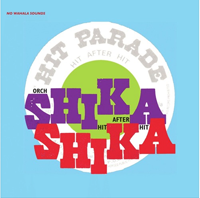
ORCH SHIKA SHIKA
HIT AFTER HIT (No Wahala Sounds)
It's odd how music can get under your skin, become more than earworms, turn into an obsession. This, I suppose is why so many of us collect records. In Summer 1983 I was sitting at the bar of Thompson's Falls Lodge, a tourist spot in Kenya, drinking a White Cap. My companions were out hiking around in the heat. Idly sitting there, I saw a hand-written note pinned to the bar: "45s 10/-." This is not new math but a clear indication of a find. I asked, and the barman pulled out a shoebox from under the bar, containing well-worn 45s that were rejects from the jukebox, some having obviously been played to death. "How much for the whole box?" I ventured. Ten shillings each, he replied, unperturbed. So while I nursed my beer to room temperature I explored the contents. First I pulled out all that were in Lingala, then I looked for dance styles I knew such as rumba or cavacha. Shika yeye -- what's that? Then the labels, ASL? sure. TPOK Jazz, have to have that. Sadly I couldn't afford all of them but took a dozen, regardless of condition and the fact the barman was still unwilling to negotiate. I was overlanding, so wouldn't be able to play them for months, but didn't want any more damage, so wrapped them securely and buried them in my backpack.
As you've probably gathered this was one of those watershed moments in my life. One of the most thrashed singles in my trove was "Tika na lela" by Lovy & Orchestre Shika Shika. Behind the layers of snap, crackle and pop lay one of the purest, sweetest ballads ever recorded. (A completely restored version is on the new LP.) And who was this band? I had heard Virunga live in Nairobi and they had a similar vibe. I started searching, pretty much in vain, for information or more from this band. It was not until the advent of [echo voice:] ¡¡¡¡Cyber Space!!!! that my explorations made any headway. I had discovered a genre of music that I decide to call "Congo in Kenya", created, naturally enough, by expatriate Congolese bands such as Virunga who had relocated to Nairobi. I started trying to plot the movement of the members of these Congolese bands and found threads running through them: this turned into a book-length opus which you can find in the above link. But remarkably, I managed to track down surviving band members. The singers of Shika Shika had all died, but the guitarists were alive and well: one was still in Kenya, one in Canada, and one in... Minneapolis, Minnesota. Through this latter, Siama Matuzungidi, I managed to piece together the story of the band, and their offshoots. This led me to other bands: Moja One, Les Jaca, Bana Moja, Bana Ngenge and on and on. But behind it all was my passion for Shika Shika. I also met a collector with the same bug who somehow had better connections to good copies of the music, but I was not jealous as he was also generous to a fault.
As my webpage grew I thought it might be a good idea to share the music -- not just scratchy MP3s passed from cel phone to cel phone or flung into cyberspace for pirates to gobble up, but properly remastered songs with contextual notes. A friend who is a music copyright lawyer suggested I put together at least ten albums and launch a label. So I started on that project, even made a booklet and a cloth box for the CDs, then Stern's issued their two CDs of Moreno & Moja One, compiled by Doug Paterson, which were far above anything I could muster: he even found brilliant unreleased tracks from master tapes! Well, I thought, it's time to launch Shika Shika on the Muzikifan label. I wrote to the Kenya Musical Rights Society and asked them if they could put me in touch with the heirs of Jim Monimambo, Moreno Batamba or Lovy Longomba. Oh, that's us! they said, You pay us and we will take care of it. Right.
No Wahala Sounds has been issuing some of this Congo in Kenya material on vinyl (Nairobi Calling; Kenya-Congo Connection), and asked me for photos from my webpages. Then they asked about the Shika Shika project. I am thrilled to say this classic album, compiled from 45s on the Hit Parade label, is now out. There are five tracks on here, each is 9 minutes long. They have been restored to crystal clarity by the "Bwana Mkubwa" (big chief) Doug Paterson. "Tika na lela" will leave you weeping. The others will get you onto the dance floor. And then while you are sitting collecting your breath, you can read the breath-taking liner notes by an authority on their music (your humble servant) PLUS, in addition, thanks to my good friend Jerome Ogola, you can also sing along in Lingala and Kiswahili, as well as understand the lyrics, which are presented in English for the monoglot audience. I am thrilled to announce the publication of this album, and hope it's only the first of many more fruitful collaborations.
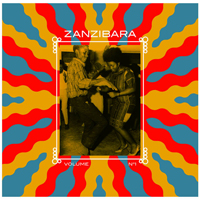
Zanzibara VOL NO 1
Taarab & Dance Band Music From East Africa (Ouch!)
I resisted CDs for the longest time, over a decade, because I simply did not trust the technology, couldn't see what was going on and experienced enough bad media to know not to trust something you couldn't fix with a needle or a brush. When I deejayed back then it was all vinyl, which sounds elitist nowadays, when many DJs show up to gigs with a flash drive or a laptop. But the vinyl craze has returned like tulipmania & the latest entry is derived from the esteemed Zanzibara series, originally compiled by Werner Graebner for Buda Musique. Since I love muziki wa dansi of the early 80s and have diligently followed the series I don't need the vinyl, but checked the playlist to see what was new or different. Of course there are some outstanding hits on here: Mlimani Park's "Visa Vimenichosha" and International Orchestra Safari Sound's "Homa Imenizidia" are both sublime. The material on disc one came out on the odd numbered CDs, Zanzibara 5, 7, and 9, with the exception of "Angelu" by Maquis Original, which was on an Ahadi cassette (AHD005) and also the LP Karubandika which is a personal favorite. Two of the songs from the Maquis cassette made it onto the first Muziki wa Dansi CD from Africassette, a reworking of Monsun's Tanzania Dance Bands, vol 2 (also compiled by Werner Graebner). On side three we find two more selections from Zanzibara 3, and have to start digging for the other tracks. Salum Abdallah & Cuban Marimba Band's "Naumiya" appeared on Dada Kidawa, from Original Music. I have not stayed up with the Taraab releases, being less keen on that genre, and checked Songs the Swahili sing (another Original Music issue) only to find the two artists represented, but with different tracks. The track "Dada" by Matano Juma & Morning Star Orchestra was the lead-off cut on Zanzibara 2, which also included the Zuhura & Party number. "Vingaravyo Vyote Si Dhahabu" by Ikhwani Safaa Musical Club was on Zanzibara 1, dedicated to them; the second track, Rajab Suleiman & Kithara's "Kimpenzi Changu Cha Moyo" escapes my notice. The closer Bi Kidude's "Kijiti" was on Zanzibara 4, which was devoted to her. It's "double LP priced," but if you have it all or most of it on the Buda CDs you have to decide if you want your disposable income going to fill your shelves and whether it's something you will play a lot or just possess as a fetish item. Having said which, the liner notes, I presume, are worth reading. And if you don't have them, the earlier muziki wa dansi releases are essential.
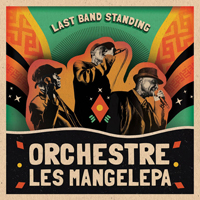
ORCH LES MANGELEPA
LAST BAND STANDING (strut 159CD)
I finally gave up waiting for those tightwads at Strut to realize my influence over the African record-buying community and send me a promo of this, and shelled out my shekels for a copy. I put it on and the Duchess, bless her, said "Don't you already have this? It sounds like every other record you buy..." So much for a varied playlist. The last Mangelepa disc I acquired was the Endurance CD on RetroAfric in 2006, a compilation of their greatest hits dating from the 70s. For this disc they rerecorded many of those songs afresh and show that after 40 years they still have the chops. Originally part of Baba Gaston's band Baba Nationale, they came East from Lubumbashi, Zaire in the early 70s. After a stint in Tanzania they moved to Nairobi where there were better recording studios. Finding themselves regularly shorted on wages, the core of the band split to reform as Mangelepa, a corruption of the French "Marquez les pas," or "Mark time," from the martial beat they laid down. In those days sales of their 45s sometimes reached 75,000 copies. However by the 80s the arrival of cheap cassettes meant they could only count on ticket sales to support themselves and attrition set in as members moved to neighboring countries as well as the UK, Norway and Canada. The core of the band is the trio of vocalists, Evany, Vivi and Macky, all other members having been replaced over the decades, apart from the bassist. But they are no mere "Stars on 45" cover band: the younger recruits also came East on tour with Defao and jumped ship in Nairobi, joining their older Congolese comrades in order to keep the band "standing." Their weekly residency at Club Vibro, playing a typical 10 p.m. to 6 a.m. gig, is quite a feat of endurance for the 70 year olds but conducive to sharpening their tunes to pinpoint focus. The liner notes by Guy Morley are thorough, if a little hard to read in dropped-out 7 point type. However he gives a good description of the various East African rhythms employed in different songs, such as Cavacha, Zebola and Chakacha. "Mbungu" as performed here, uses a riff from "Djamo Djamo" by African All Stars, but the original melodies soar over the martial drumming and even the old farts will shake a leg.
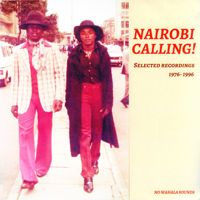
NAIROBI CALLING!
SELECTED RECORDINGS 1976-96 (No Wahala Sounds NWS5)
I was a little harsh on the No Wahala crew last time out for their excellent Kenya-Congo Collection LP. My objection was that, fine as the music is, they were trying to get too much into a 40 minute vinyl album and consequently there was a lot of "part ones" that were just getting going when they ran out, and it seemed to me they should have given us fewer tracks in their entirety, or else extended to a double album -- or done a CD in the first place. While the Kenyan tracks on Nairobi Calling! are good, the "Congo in Kenya" ones are outstanding. Of course you'd expect me to say that, but the three expatriate bands (which are all interrelated via personnel) are Baba Ilunga wa Ilunga (i.e. Baba Gaston and his group), Bana Ekanga and Moja One, the brainchild of Moreno Batamba, a singer who has had two excellent compilations from Stern's in recent years. This new offering is more satisfying than No Wahala's first in that there is only one abridged song, and this is Bana Ekanga's "Amemiki part 2"-- I don't mind because I have the whole thing, but then you may not be so forgiving. Bana Ekanga was one of the transitional bands between Baba Gaston's pioneering Baba Nationale and later groups that spread the Congo sound over East Africa. Bijou Ley & Nana Akuma (later of OK Jazz) were the vocalists, alongside Kasule Mopepe, Dago Mayombe and Ochudis. Siama the rhythm guitarist and Lava Machine the drummer were later key members of Shika Shika, Bana Ngenge and Moja One, so they complete the bridge to Moreno's band. Siama and Moja One bassist Tomy Lomboto are seen on the cover in a photo from this website which the producers have reworked for the worse. For my money Bana Ekanga are worthy of a least a whole CD or double-album reissue. But that's not even the best track on here. The Baba Ilunga track, "Nakuomba," has never appeared before. Why it was left in the can is a mystery but shows how great the musical outpourings of the expat musicians were when they entered the studios in Nairobi back in the late 1970s. The two Western Kenyan Benga bands, Victoria Chomeka and International de Nelly, hold their end up pretty respectably in two succinct numbers. From them you also hear the mi-solo breakdown and spare drumming parts that were picked up on by the Congolese immigrants to perfect their sound. A longer exposition is heard from Biashara Jazz Band, who played in Tanzania. Moreno was an earlier adopter of the local scene in Nairobi (and also Dar Es Salaam) and sang in Kiswahili with an achey breaky voice, which made his wonderful music even more accessible to the locals. His "Maria" absolutely raises the roof at all corners and is a brilliant capper to this fine compilation.
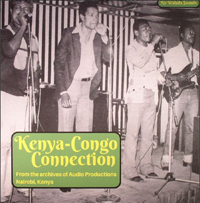
KENYA-CONGO CONNECTION
FROM THE ARCHIVES OF AUDIO PRODUCTIONS NAIROBI KENYA (No Wahala Sounds NWS3)
Hot on the heels of the Urgent Jumping set from Stern's and Soundway's Kenya Special Volume 2 we have a third reissue this year of classic East African oldies to celebrate. I knew about this because the compilers No Wahala Sound contacted me about using artwork from my Congo in Kenya page. I coined the term "Congo in Kenya" to describe the expatriate bands from Zaire who played in Kenya and Tanzania in the 70s and 80s a decade ago when I launched muzikifan, and this site is certainly the only place online where you will find so much information about the genre. No Wahala have accessed a great LP from the Hit Parade label, Muziki Mix (1983), via Doug Paterson, the acknowledged expert on the field. That album contains four tracks: "Solongo" by Bana Sambo, "Mkamba's day" by Kilimambogo Brothers, "Massa" by orchestre Shika Shika and "Bolingo ya lokuto" also by Bana Sambo. This new album contains part one of "Solongo" and "Mkamba" and both parts of "Massa." This is one of the limitations of vinyl, since the producers decided to include a few other tracks they also opted for part ones only. A reproduction of the original album would have been welcome. But I am glad to see my favorite genre of African music get so much attention lately. The producers have managed to cram some other tracks on here also: "Mado Zaina pt 1" by Bana Likasi which you probably have on the Nairobi Beat album -- one of the first great (wonderfully sequenced) Kenyan comps which Doug Paterson put together for Rounder Records in 1989 while he was still working in Kenya. The Kalambya Sisters were also on that Rounder comp and are present here with "Wavinya." Two other A sides make the cut, both by Issa Juma and Super Wanyika who were based in Tanzania. Wanyika give us "Nifanye nini" which might be a remake of a Cuban Marimba Jazz tune, and "Wafanyi kazi." These are both rarities which fans will want to hear in full. But what fans want is the full track, both parts, as one Colombian fan said, "part two is the climax of the song." So maybe No Wahala can be persuaded to offer the full versions as download or in a CD format, or if they keep making vinyl albums, consider a double album, since 40 minutes seems quite constrained when you have a lot of music to get to.
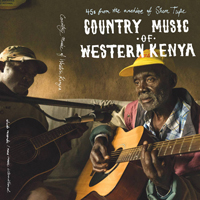
SHEM TUPE
COUNTRY MUSIC OF WESTERN KENYA (Olvido Records)
Olvido Records of Portland, Oregon, have caught up with Western Kenyan music legend Shem Tube and his pals, including Enos Okola on kitchen percussion, for some new recordings from the guys who brought their guitars and Fanta bottle to the limelight with the Abana ba Nasery LP on GlobeStyle back in 1989. Subtitled "45s from the Archive of Shem Tupe," it's a collection of nine digitally restored 45s with Enos Okola and Justo Osala, the original Nursery Boys. You can listen for free on Bandcamp at the link above, or buy the music on download for a mere $5, or get a limited edition (high-bias) cassette with a printed cover for $7. They first brought Luhya music to our attention back when ambitious labels in Europe were opening up the music of all the world to our ears. The Nursery Boys even got the full "Mustapha" treatment on a trip to the UK when their second album, Nursery Boys Go Ahead had a welter of guests artists, on violin, banjo, bagpipes, slide guitar, bouzouki, etc. (I skipped that one.) They sometimes have electric bass on here, but otherwise it's their vocal harmonies and sympathetic two guitars along with rattling metal thingies. It's by no means the left-overs from their earlier session, but pure Luhya music from the late 60s and early 70s, some of which were hit singles, found and restored by Cyrus Moussavi of Raw Music International who mentions that all proceeds go to the band. "Wesimba Omurwe" will make you prick up your ears because the first chord is pure Jean Bosco Mwenda, then it goes off into another tune, but it's a reminder of the shared heritage of a lot of African acoustic guitar, as well as its magic.
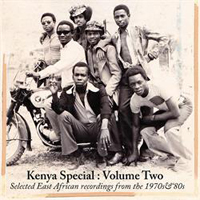
KENYA SPECIAL VOLUME TWO
SELECTED EAST AFRICAN RECORDINGS FROM THE 1970s & 80s (Soundway SNDWCD084)
Now that I have resumed my old trade of disc jockey with a fortnightly podcast I have returned to thinking about the importance of sequencing. A really fine example, with a complex playlist, is the Voyager's Golden Record, a 3-hour set that was blasted into outer space to convince aliens there is intelligent life on earth. But since this stellar mixtape was accompanied by a couple of nude selfies, the aliens will doubtless think we are creeps or worse, swingers. However, I put it on, courtesy of YouTube and was really impressed by the way Louis Armstrong sat next to shakuhachi flute and the way Bach filtered in and out of the mix alongside Javanese and African tunes. If you listen to the Soundway Kenya mix you will think it's a collection of music from all over Africa, not just East Africa. There's funk, highlife, even mbaqanga in here and it gets off to a jerky start. Track one, the Lulus Band's "I can feel it," is overmodulated and a bit shrill. Sung in English, it's about the happy end of the world. Their other entry here, "Daina" would have made a better lead-off track. Track two, Bahari Boys, has a Taarab influence, but fast with Ethiopic sax, and is followed by more shrill benga. Conga International come up, with solid Congolese rumba from Johnny Bokelo though showing a highlife influence. Props to the compiler for finding this (I have it on a SonAfric LP titled "Sana Mama" and credited to Orchestre Kouloukoko du Zaire, which apparently was done to avoid contractual obligations). Congolese music was big in East Africa in the 70s and so lots of singles were reissued in Nairobi from Zairois labels and some were pressed there during vinyl shortages in Zaire. This track "Nakupenda sana," is the first peak moment. (My favorite cut on the previous Soundway Kenya comp was also the Congolese one: Vévé Star's "Nitarudia.") But things are not building here, as we crash back to benga. Country and Western music for the Luo. The marketing hype accompanying the release (I didn't see the liner notes when writing this review) talks about "otherness" versus juvenescent club culture, and it is a load of bollocks. I really don't see young clubbers getting into this. After they burn out on the Fela clones will they discover Manu Dibango or Hugh Masakela next? I suppose the hope is they will hear Les Mangelepa or Simba Wanyika on here and create a demand for reissues of those fine acts. Mangelepa's "Nseya" is another big hitter (from their 1982 Seventh Anniversary album, celebrating their defection from Baba Gaston). About the mid-point we get to the key track: the sublime "Nakupenda (I love you)" of Simba Wanyika. Not to be confused with orch Conga's "Nakupenda sana (I love you very much)" or even Simba Wanyika's "Nakupenda cherie (I love you sweetie)" which came out on their 1992 CD Pepea, recorded in Europe and a lot slicker. "Nakupenda" is the longest cut on here and they could have used a couple more nine minute barnstormers to ground this, and ditched the 2.5 minute novelty numbers. But we return to the diverse miscellany approach with some tracks that befuddle me, as to why they were included. "Libondela" by Afro 70 is a South African cover and completely derails things; then we hear what sounds like a Bollywood movie tune "Harambe" by Mac and Party, a piece of vintage taraab. It may be a failing of sequels that they can never live up to the original, and Soundway's first two-volume Kenya Special is indeed a very special collection. Even the Eagles Lupopo track "Mrembo pesa (Miss Money)," which has a "Tighten up" vibe, gets irritating on repeated listening. But this is an interesting compilation precisely because of its diversity and while I may not listen to it all the way through repeatedly, there are definitely some gems on here worth knowing.
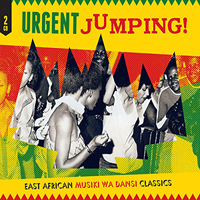
URGENT JUMPING:
EAST AFRICAN MUSIKI WA DANSI CLASSICS (Stern's STCD3067-68)
I have been waiting for this release for some time. I held back my review of the Soundway's East African comp above so I could write about them together, consequently I have listened to the Soundway comp over a dozen times. On first hearing the Stern's offering one thing is clear: it's much better sequenced, the music flows logically and there's no lurching about from genre to genre with novelties thrown in to derail it. In fact the compiler says he thinks taarab deserves a separate comp and of course that is true. Some of the same groups are included, indeed some of the same tracks. A high point on both of these new compilations is Johnny Bokelo's "Nakupenda sana," which was hiding in plain sight on an LP from Editions Esperance. So, was there industrial espionage on here? "Sina Raha" which was on the first Soundway comp is repeated here. How did both comps end up with this same song, and why does Stern's include it if the compiler started off with 1000 tracks? And why does disc one end with "Dunia ni duara" by Moreno and Moja One since ALL African music fans have the recent Stern's album compiled by Doug Paterson that includes it? And this may be a good time to ask why Doug Paterson did not write the liner notes? The compiler says "Starting in the early 60s, Congolese bands flooded East Africa. Those from Northeast Congo headed for Kampala, from the southern Shaba region to Dar, and all to Nairobi to record." If that sounds familiar, it's the lede on my page on Congolese bands in Kenya: "Those from North-East Congo came to Kampala, Uganda; those from Shaba in the South came to Dar-es-Salaam, Tanzania, but sooner or later they headed to Nairobi for the recording studios there." Despite this unimpeachable source he allows far too many typographical errors to creep in: the title is "Musiki wa dansi" which is wrong. The word he wants is MUZIKI. In Tanzania Muziki wa densi refers to secular music; also he frequently uses the term "zilipendwa" which translates as "they were loved." When referring to those songs which were loved the word is "Zilizopendwa," though "they" can be understood from the context. There are other irritating small errors in here too: Johnny Bokelo's band was Conga Internationale not Congo, Les Maquis were "du" Zaire, not "de." Still, it is readable which is more than can said for most CD packages, but then the Soundway sets have fantastic design with lots of band photos, ephemera and labels which are notably lacking here.
Now I have made it to disc two and again there is a track repeated from the first Soundway comp (as if it didn't exist): Afro 70's excellent driving "Cha Umheja." Also Sunburst's "Matatizo nyumbani" was recently reissued on Ave Africa: The complete recordings by them. Yes, these five duplications are good cuts but we could have heard some of the other 1000 singles the compiler has that have not been recently reissued. He even holds out a carrot, saying there's a great rare Super Mambo track, maybe implying if we are good there will be a second volume. The "Muziki wa densi" genre refers to Tanzania, but here is one instance where borders are permeable and there's lots of the rumba and benga flavor of Congo and Kenya, as well as the excitement of what sound like live recordings: one take, no multi-tracking. The crystal clarity is another asset of this Stern's set, most of the tracks coming from master tapes in the possession of A.I. Records. The discs should prompt you to start compiling your own set of the thousand best East African tracks.
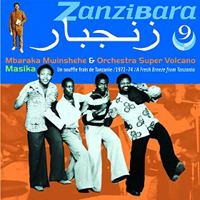
MBARAKA MWINSHEHE & ORCHESTRE SUPER VOLCANO
MASIKA: 1972-74 (Zanzibara 9 Buda Musique)
The Super Volcanos are intense, talented, confident. When their leader, Mbaraka Mwinshehe, sings and plays guitar the rest of the band are inspired too: the trumpeter solos, playing jazzy counterpoint to the vocals. Everyone is carried along on the exciting rush. The horns, which add punctuation throughout, lend an excited tone to the production. The spontaneity of a live show is captured in each selection of this fine compilation as Buda Musique continue with their wonderful Zanzibara series, drawing on the musical heritage of Tanzania and the East African coast. The even numbers in the series are Taarab and other traditional music, while the odd numbers are (mostly) the muziki wa dansi that is irresistible. Volume 3 presented the 60s sound, including Jamhuri Jazz, NUTA Jazz, Atomic Jazz and Morogoro Jazz. Volume 5 covered 1978-83, pitting Mlimani Park Orchestra against Dar International, while volume 7 posed Mlimani against I.O.S.S. from the mid-80s. Now we have gone back to the early 70s and one key band, which evolved out of Morogoro Jazz. Drawing heavily from two of the LPs in Polygram's Ukumbusho series (vol 4 and vol 6) we now get to hear Mbaraka Mwinshehe with his band Super Volcano in clarity, with contextual notes, photos and song lyrics added to the restoration. Ukumbusho means "souvenirs" and the remembered good times were spread over a dozen or more albums that appeared in the decade after Mbaraka's tragic early death (aged 34) in 1979 (These included "The Last Recordings" [polp 512] which was followed definitively by "The Very Last Recordings" [polp 517]). Mbaraka's earlier band, Morogoro Jazz, was given its own retrospective on the Dizim label in 2000, with Masimango (Dizim Asili 4702-2). Like "Daktari na mimi (The Doctor and I)" on vol 3, "Morogoro HQs ya Volcano" is a slide guitar tribute to Dr Nico. This was on a Polydor album POLP504 issued in 1974 and tracked down by Doug Paterson; it may have been reissued as vol 12 in the Ukumbusho series, who knows? One track on here, "Posa Na 2" is new to me, but then I am a Mbaraka completist. There is a "Pesa No 1," which is quite different, on a couple of Mbaraka LPs. According to Douglas Paterson it means "Wedding proposal no 2" and is about a brokered marriage where the broker absconded with the dowry. All of Ukumbusho vol 6 is included. Three tracks from volume 4 and one from volume 7 complete this set. Unless you have mint vinyl copies, you probably have not heard these songs with their urgent live-room feeling. There is a raggy sax and trumpet that complement Mbaraka's singing, but his guitar playing is up there with the greats -- Nico & Franco -- to whom he was often compared. The sound is clean, I can hear a clave and guiro in here which were just "surface noise" before on some of the low-fi recordings I have heard.
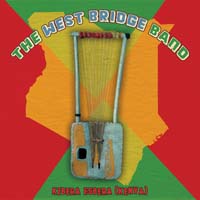
THE WEST BRIDGE BAND
KIBERA ESBERA (KENYA) (Electric Cowbell ECR713)
This is refreshing: an album of traditional Kenyan music, played with a lot of energy on home-made instruments. The players and singers are Luhya men, four of them, led by Wamalwa Lusweti on the Litunga, a nine-stringed instrument he invented and built. It looks like a lyre; there's also a one-string fiddle prominently and vigorously sawing away, and percussion provided by rattles and something, perhaps a cow-hide covered wooden drum, being struck. The other homemade instruments are the Sichenje ring and the Shiriri. Curiously this is not a CD release: your choice is limited-edition vinyl or digital download: could this be the first sign of the end of the CD market? Personally I think they should bring back the shellac 78 (they are durable and don't require electricity). Although the music sounds traditional and would not be amiss in the John Storm Roberts or Hugh Tracey archive, the songs are about modern life in rural Kenya: beware of being struck by "flying toilets" warns one. This is a reference to plastic bags full of shit which people throw out of their houses after dark, into the bush. I doubt they yell "Gardez Lieu!" as they do this. It's far from the beaten track, in fact the local moto-taxi boys, who are high on mira weed, rob tourists by stringing wires across the road to knock them off their bikes, often killing them. One mzungu who made it through is Grammy-award winning producer Ian Brennan who made the recordings. He discovered the band's secret: they often perform in Nairobi for tourists and during their set go off stage and change costumes and return to play music from different tribes, making the audience think it's a rotating roster of bands, when in fact it's the same four guys displaying their versatility. (The venue is not identified but I suspect it's Bomas of Kenya, a tourist site with different tribal styles of building on display, where you can also eat rare meat, like gazelle, when the parks service culls them.) Check out the West Bridge Band of Nairobi on YouTube here. The last song is in pidgin english so the full pathos of the lyrics finally hits you.
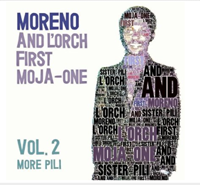
MORENO & L'ORCH FIRST MOJA-ONE
VOL TWO: MORE PILI (AIT Digital/Stern's -- digital only)
Moreno has a voice that puts him in the ranks of Sam Cooke, Marvin Gaye, Greg Isaacs, Solomon Burke and Al Green, so it is a delight to have more Moreno. I have had some of these tracks for a long time, and listen to them frequently, but it is a treat to hear them restored from the original tapes and cleaned up by the tireless Doug Paterson. On one of his trips to Kenya, Doug secured the master tapes from A.I.T. and there is a picture of the box on his own website. The heavily doodled box shows that the tape contains four songs which were recorded on 14 December 1981. Two of the tracks were issued as singles and two were unreleased until now (not that they are any less great than those that came out: in fact "Sisili" is smoking hot). Paterson recalls hearing Moreno in Nairobi and being blown away by his deep, explosive voice: "With its precise intonation, an all-enveloping rich bass and a timbre which could suggest a distressed psyche, it was an unusual sound for a lead vocalist in East Africa." Indeed Moreno is unique and unmistakable and you can hear him singing with Bana Ngenge or Les Noirs, not to mention Shika Shika, Virunga, and IOSS. When I saw Virunga in Nairobi I thought he was the lead singer. The cuts assembled here are earlier than the tracks "Adidja" and "Danger Girl" from volume one which you doubtless own. They were originally on the one LP issued by L'Orchestre Moja-One. Another unique aspect of Moreno was his fidelity to his girlfriend, Pili, a Tanzanian model. He sang about her in "Sister Pili" and here celebrates her again in "Pili Mungwana." One of his monster hits, "Dunia ni Duara," is included. One line in it puzzles me: "Attaquez les Americano!" but then I don't know what it's about and sadly there are no liner notes in this etherial issue. Moreno also mentions "San Francisco" so perhaps he was being dashed by tourists. "Mariana," another of the unreleased tracks -- a ballad -- is sung in English & Kiswahili and has electric piano. It kicks up a notch at the seben. We have a rough idea who is on here: there are shout-outs to the hard-working drummer Lava Machine, but you might be misled by the calls to Jacomo (that's Felix the producer). But fortunately the professor, Siama Matuzungidi, is still with us so I asked him if he remembered the line-up. He replied that he thought Sammy Mansita played lead on two songs and provided names of all the musicians who were assembled in High Fidelity Studios in Nairobi for the session: "Moreno Batamba (singer, composer of all songs), Coco Zigo (singer), Dago Mayombe (singer), Gina Monganza (singer), Jacques Akomo (lead guitar), Mokili (lead guitar), Roy (lead guitar), Siama Matuzungidi, given name Rivancliff (rhythm guitar), Joniko Walengo (bass), Tommy Lomboto (bass), Lava Machine (drums), Caster (drum), Papa Joe (keyboard)." In "Sisili" (different from the Shika Shika song of the same name), Moreno names the singers, as well as a shout-out to Lava. "Sitaki Mambo" is unusual because it has a reggae beat, an inverted version of "Stir it up." Though not recorded in this session, it is another rarity unearthed by Paterson for inclusion here. Believe me there is more of this quality waiting to be reissued, so the bottom line, readers: You need to buy this so we get volume three!
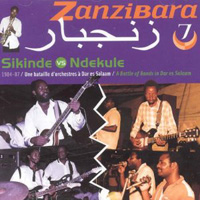
ZANZIBARA 7
SIKINDE VS NDEKULE (Buda Musique)
It seems the odd numbers in this series are the ones to get for fans of "Muziki wa dansi," which was the widely popular music of East Africa in the 1970s and 80s. The even numbers are traditional Taarab music, but vols 3 and 5 have been brilliant compilations of rare, often never before heard, and beautifully restored classics that lit up the East Coast of Africa from Radio Tanzania and clubs from Malindi south to the verges of the Okovangu swamp. There is one small disappointment about this new release and that is four of the eleven tracks have appeared before on two compilations that I know any serious collector of African music has on their shelf: Tanzania Dance Bands vols 1 & 2, which came out from Monsun Records of Germany in 1989 and 1991. Actually volume two of that pair had some technical problems and was reissued with a revised tracklist from Africassette in 1995 (they dropped two and added three songs). This disc pitches International Orchestra Safari Sound [IOSS] against Mlimani Park in a friendly duel, with half a dozen tracks from each band. (The apparent rivalry was fomented by the singers and guitarists moving between the two bands.) The album kicks off with Mlimani's "Mtoto Akililia Wemba" which was on Dance Bands Vol 1. It's inclusion here is didactic as well as for the obvious reason it is fabulous; it also tells of the rivalry between these two bands. Their catchy song "Neema (My blessing)" was also on that earlier Monsun disc. The two IOSS tracks that are repeated are "Chatu Mkali" and "Homa Imenizidia." The latter was the song that provoked Mlimani's "Mtoto Akililia Wemba." The repeats come in the middle of the album as a solid core to remind you how brilliant this music can be or convince you if you don't have the Tanzania Dance Bands CDs. Still, three new songs from them is a welcome addition from a great band whose only known issue to me is two tracks on a vinyl album called Tanzania Hit Parade '88, issued by Ahadi Records of Nairobi. Then there are the cassettes: There were a dozen FLATIM cassettes issued of Mlimani Park, but only 4 I know of by IOSS (The songs here mostly come from the Christina Moshi cassette [MSK/CAS505]). The advantage of cassettes is they don't skip or get scratched; the disadvantage is the sound is usually muddy because they were dubbed at high speed from second-generation masters on cheap stock, using gummy equipment. But the master tapes are in the Radio Tanzania archives (those that haven't gone missing), so there is still hope of some more gems coming from that source. This storming big band sound is a treasure. The lead singer of IOSS (Hassan Bitchuka) has a wonderful voice which you can appreciate fully here. Sweet harmony vocals, speedy guitars, bubbling bass, four on the floor drumming, punchy trumpets, warmly warbling saxophones. Even if you recognize the grooves you will have a hard time taking it off once you start playing it. This comp makes them new, dusts them off and reframes them for another whirl.
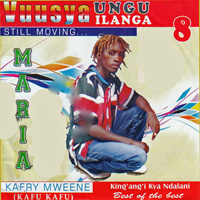
KAFRY MWEENE
MARIA (Africa Entertainment KAMBA Ltd)
I often rely on the kindness of strangers to alert me to new music. Not that Ken A is a stranger: while I have never met him, he regularly e-mails me about music developments that interest him and I am particularly grateful that he turned me onto this new release from Kenya. A cursory search for Kafry Mweene shows that he has at least four albums out and there are loads of Youtube videos of him (though the artist is labeled Mwenjoy wa Kathambi), so you can cut to the chase and tell if you like it. His nickname/catch-phrase is "Kafu Kafu" which is Kiswahili for "very witty," but I am guessing it refers to the "cough cough" interjection you hear in his songs, presumably because he smokes so much ganja it has given him a bad cough. His music is speedy Benga and he is backed by exceptional musicians. Two busy guitars, pulsing bass and relentless trap drums. That's all he needs, plus a chorus, and someone blowing a whistle now and then when the dancers' bums are no longer going at 320 bpm. If you are not already a fan of the genre, it may sound all the same. There are definite musical figures and rhythms associated with it, however these lads know it inside out and attack it with vigor.
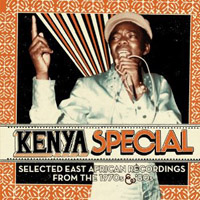
KENYA SPECIAL (Soundway Records, 2xCD, or 3xLP)
Like Soundway's earlier comps, Ghana Special and Nigeria Special, the idea here is to present some lesser-known tracks interspersed with polished gems to document an historic era in African music. If you've visited Fredrik Lavik's afro7 site, you know he has been posting Kenyan oldies (Benga, Cavacha and so on), and he has contributed much to this new compilation, including the elegant design (and very legible typography). Douglas Paterson provides the in-depth scholarly liner notes and context for each of the 32 selections. But this is not your father's Kenyan oldies collection! While most of us think of Kenyan music as either indigenous Benga from the Luo people, Swahili pop, or the imported Congolese rumba arriving via Tanzania and Uganda, there were also bands playing funk, and other varieties of music, and so a wide spectrum is covered here. Most of the songs are A-side singles, so only 5 mins tops. The album starts with a fanfare, which may have been inspired originally by James Brown, but is derived from Afrisa International's entrance music from FESTAC. This is Loi-Toki-Tok's "Ware wa"; another from them on disc 2 sounds more like a "Mutuashi" beat. We continue in a Famous-Flames vein, and could be anywhere in Africa. Afro 70 get three entries and, as Paterson points out, their style was influenced by West African "Afro" music. Their "Week End" (included here) from 1972 is a bona fide classic. The funk vein is dominant (which you can expect from Soundway's agenda) though obviously Benga strains can be heard. Orch Vévé Star (a Verckys band who made it to Nairobi via Uganda) sing in English and have the added attraction of a piano, heard while they hold down the funky groove. There's an organ-churning beat to the Taarab ballad "Sina Raha," performed by Hafusi Abasi, backed by Slim Ali and the Yahoos Band. Slim explains the Kiswahili lyrics in English in this moody entry. The emphasis is on American-sounding music but there are still great moments for fans of the more recognizable Swahili sounds. "Sweet sweet mbombo" by Baba National is another classic (again with pidgin English lyrics). Super Volcanos turn up the heat behind Mbaraka Mwinshehe on another Polydor 45, "Mngeni mali yake yoke," with his recognizable arab-pitched vocals, two-fingered OK-Jazz-style guitar lead and big horns braying in the distance. By the middle of the second disc we get to a solid run of Kikuyu pop from a series of "boy"-bands: Kalambya Boys, Huruma Boys, Gatanga Boys and The Famous Nyahururu Boys. You could make a good case for a Country & Western influence on the guitar styles here. The Lulus get three entries and Eagles Lupopo get four. The diverse mix of styles (plus licensing from many companies) bodes well for future compilations too.
[n.b. The backstory on Fredrik Lavik's quest for Kenyan vinyl can be read here. Also note there is an EP of four disco remixes that includes some excellent grooves aimed at the contemporary dance floor.]
ORCHESTRA SUPER MAZEMBE
MAZEMBE@45 RPM VOL 2 (Stern's)
The great Orchestra Super Mazembe are back in a flash! Two months after their superb Mazembe@45 compilation on Stern's, here's another helping of nine more fabulous 9-minute singles. But you'll have to reread what I wrote about volume one, because there are no liner notes, not even writing credits, for volume two, which is download only. And since you can't buy it on a CD you should try to get the highest quality possible, so you may have to wait. You can get it at 320 kbps from 7digital in the US, from emusic, or if you want FLAC, wait and get it from boomkat, who are offering the Stern's catalogue in higher quality, but they are slow in getting it on line. Once again Doug Paterson has lovingly restored the tracks from the master tapes, and, where none were available, he has taken the original 45s and remastered them, seamlessly joining the A & B sides. It's a real pleasure (especially for me, as currently I listen to this genre of music probably more than any other) to hear such clean recordings. This is certainly as good as volume one, Mazembe were on a roll in 1977 and 1978 when they recorded these sides. Katele Aley and Lovy Longomba are all in full voice. I'd only heard one of these songs before (Lovy's "Yo-mabe") which I have in a scratched 45: the whole set rocks. Great sax, four-on-the-floor drumming, and the weaving guitar magic of the front line, featuring Bukalos. I like this as much as the first release, maybe even more, the sequence is great. "Aleseia"-- I know this refrain -- there's a reggae shuffle, even a taste of Zaiko and things to come. I miss Paterson's synopsis of the lyrics. The last song is clearly religious (about a big god, according to my understanding of the lyrics), but it may not be devotional. And "Sala keba" tells you to "tika na lela" which means "leave and weep."
SHIKAMOO JAZZ
CHELA CHELA VOL 1 (RETRO9CD)
My page devoted to the music of Kenya and Tanzania was getting unwieldy, at over 50 entries, so I decided to divide it in two. At first I thought I could separate out the bands by nationality -- nothing easier, right? Then it occurred to me there were so many Tanzanian bands that ended up being huge in Kenya (because of the shared language) that I decided to ignore borders and leave them as one category. But I also noticed I had not reviewed one of my favorite CDs: Chela Chela, which came out on the Retro Label of London in 1995. (When I reviewed for WIRED magazine and a couple of other websites, including one run by MTV, before I started muzikifan, they had copyright on my work, so sometimes great discs didn't get reviewed here.) Shikamoo means "respect," and the idea behind the band was to give some respect and love to the elders. The band was formed of old-timers, men who had been in bands in the 60s and 70s, who got together to jam on some of their old hits. So it's a new recording with an old sound, which means we get classic Tanzanian rumba but it is well-recorded for once! The men are veterans of some of the most renowned muziki wa dansi groups: Orchestre Maquis, Les Wanyika, NUTA Jazz, Kiko Kids, Vijana Jazz, etc. In 1994 the band toured the country and then took up a residence at a hotel in Morogoro and, inevitably, began writing new material! They call their relaxed style "Chela Chela" and though it looks like Volume 1 is all we are going to get, it's a treasure. The sound is dreamy, and they even slow it down further for the great ballad "Nakuomba Radhi," which has reedy organ, and bird calls on it. The music rises to a transcendent passage in the middle with two tracks "Mpenzi azizi," and "Sumu ya Ugonjwa ni dawa," that carry you away to the empyrean, which is all you can ask of music (no drugs required).
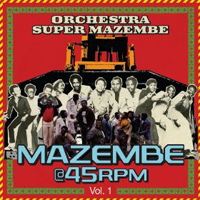
ORCHESTRA SUPER MAZEMBE
MAZEMBE @ 45RPM VOL 1 (Stern's)
I've told this story before, but at the time I was in East Africa 30 years ago, being blown away by the music, I had no idea it would become a lifelong obsession with me. When I returned home Talking Heads sounded jerkily arrhythmic, Einsturzenden Neubauten, Wire and Public Image Ltd were no longer even tolerable (I sold or gave away their records), and all I wanted was to find and listen to more Congolese, Tanzanian, Zambian and Kenyan music. One genre in particular held my attention and that was the bands who played in East Africa but came from the Congo basin and sang in Lingala. I had seen Orchestra Virunga of Samba Mapangala and Moreno in concert in Nairobi and my interest quickly fanned out from them like a brushfire. That these bands are all consistently great, even the really obscure ones like Orchestre Kot Kot or Grand Piza, is due to the fact that they had a fluid membership drawn from the pool of expatriate musicians in Nairobi. I am not saying they sound alike but there are familiar voices (such as Fataki Lokasa), familiar rhythms (e.g. the Cavacha) and even catch-phrases ("Sikiya sauce!") that echo between these bands. Among the best was Super Mazembe, the "Earth movers." Their new Stern's album is another dream come true: It sounds as fresh now as it did 30 years ago, which says as much for the music as for Doug Paterson's loving restoration of the singles from A-side B-side tracks which had lain forgotten for three decades. If you poke about cyberspace and YouTube you can find enthusiasts for this music, usually content to listen to fried third-generation versions taken from the famous much-bootlegged originals found in the shacks on River Road or the "scruffy dukas" along the Thika Road (as my sister-in-law called them) and now worn down and scratched. Super Mazembe were one of the most successful, they even had LPs released in Europe (on Virgin and Disc'Afrique). Their genesis was in Orchestre Super Vox, formed in Likasi, Zaire. The leader of that group, Mutonkole Longwa Didos, moved to Nairobi with a core band in 1974. Katele Aley was lead singer and composer (he wrote most of the songs on here); Kassongo Songoley played rhythm guitar while Kassongo wa Kanema was another singer. In Nairobi their ranks were strengthened by Loboko Pasi (guitar), Fataki Lokassa (singer) and high-register vocalist Lovy Longomba, who like Baba Gaston, was also from Likasi and even used the name Bana Likasi (Likasi Kids) on some recordings. The hits flowed from their creative fusion and they released a staggering 42 singles on their own label Editions Mazembe and several on the Zambian Luapula label of Nashil Pichen Kazembe, who also wrote and sang with the band during his sojourn in Nairobi. Here we have nine choice examples of their style, each eight and a half minutes or so of brilliance. The vocalists state the subject (often homilies about interpersonal relationships: "I cant find a job, everything has an end and eventually my suffering will end, but for now I need help," or "My husband drinks all his wages. How can I raise the children? Maybe I should marry his brother?") in sweet harmony, then from about two to three minutes in, the drummer knocks his tomtom twice to signal "Here we go!" The guitarists step up and start to weave complex webs around the melody. But they are reined in at the four minute mark and the vocalists return and it sounds quite literally like the band is falling apart: the lead guitar sputters and conks out, the vocalists sing the harmony only, one of them yelps and calls out names, soon all we have is the manic drumming and the rhythm guitar, suggesting everyone else went to the bar or the bathroom. But we are in capable hands: the others are simply concocting a surprise (and what is happening in the studio is the engineer is giving them a wind-up signal as he is planning where to slice the song into two parts). As you know part two is a free-for-all race to the finish, and it's not uncommon to hear the rhythm guitar or even the bassist get a shout-out for their sudden inspired innovation. It's as close to a live jam as you can get without the attendant problems of live recordings which are often great in memory until you hear them back and the vocals are off-key or one player is too loud or the sound is muffled. The sound here is generally clean and bright. The selection is fabulous and bodes well for future volumes (I was never that impressed with their so-called "Greatest Hits" album as it had a couple of cover tunes including a Buddy Holly song which was a novelty item and not that memorable). This is what they are all about: Aley Katele's sharp songs (all the lyrics are explained), Bukalos Bukassa's lead guitar, solid drumming from Dodo Doris or Ngoi Kitenge wa Kitombole, Atia Jo on bass, and a revolving roster of back-up singers, animators (in-style guys who dance and shout encouragement) and third and even fourth guitar players dicing in some extra riffs. Among influences you can hear OK Jazz on "Amina." All the tracks are exceptional & I do hope Stern's have turned Paterson loose on the next batch of tapes.

BLUE FLAMINGO
A SEARCH FOR CMS (Excel 90306)
You may know the Blue Flamingo label through Ziya Eretekin's elegant blog about classic 78s. Last year he went to Nairobi searching for information about a label, Capitol Music Store (CMS) that flourished in the postwar era alongside Melodica and AGS. The fruits of Ertekin's trip are the 14 sides collected here that showcase the development of acoustic folky music into benga in the era before the Congo sound began to influence music in Kenya and Tanzania. It's a handsome package, with a 26-page booklet to enjoy while you bask in the bygone sounds. For me it's wonderful that so much great African music is being unearthed and treated properly with the respect it deserves and not just ripped and uploaded from scratchy or dubious source material. You can read the liner notes on Ertekin's website, and follow his crazy serendipitous one-day trip to find out more about CMS. A taxi ride from Melodica brings him to a musicians' convention where he meets Joseph Kamaru, formerly a very successful singer, who had bought CMS when the Indians were forced out of business, and renamed it City Sounds. Then he runs into George Mukabi's son who gives him an impromptu concert, so all in all Ertekin has a phenomenally productive day in Nairobi. His compilation is a choice set of 14 sides that chronicle the music in a familiar way (So familiar that Ben Blastus singing "Mpenzi nipe pete" put me in mind of "Brown-eyed girl" by Van Morrison!). Things turn electric with Victoria Revolution 73, a full-blown Benga band. We go back to guitar and Fanta-bottle and then ease back into electric pop with the mellow sounds of Melodica Success: the singing is still benga style, but the trumpet and guitar styling are reaching into the pan-African musical pool. They even call out "Mutuash!" at the seben. The most famous artist on here, after George Mukabi (who gets two selections) is John Ondolo who also gets two selections, "Shokoloko Bango," and "Kilimanjaro." There is also a nice balance between acoustic and electric tracks.
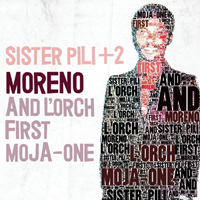
MORENO and L'ORCH FIRST MOJA-ONE
SISTER PILI + 2 (Stern's STCD3062)
You know there's one thing I love dearly and that is classic Congolese music. There's also the variety of expat Congolese in Kenya that I have devoted many column inches to, explaining that the musical scene in Congo was so rich in the late 70s that bands went East looking for gigs and many settled in Uganda, Kenya and Tanzania, reinvigorating the local scenes. These musicians flowed in and out of different configurations but there were several key performers, including arguably the finest singer of the era, Moreno, subject of this reissue. It consists of a fine album with never-before-known bonus tracks. Moreno was handsome and charismatic, as well as having a rich bass voice that is on the verge of cracking, lending it loads of emotion; his charm extended to eliciting the best performances from his musicians.
The combination of dueling lead guitars, sax punctuating the harmony, and pounding bass is irresistible. It sounds as though they are jamming live in the studio and the tunes have all the excitement of first takes, urged on by a very excited Moreno. After all this is the "First" band, not only that, First Moja-One. (As any African traveller learns, "Moja" is Swahili for "One" so Moreno is overstating it just a bit!)
The album, Sister Pili, returns in glorious sonic fidelity thanks to Doug Paterson. When I record old scratched LPs I tend to leave them alone; I know from years of playing with Dolby, hi-bias and/or cheap cassettes that anything you do to a signal is only going to cause it to degenerate. Doug got hold of the master tapes and they've been sonically cleansed to an unbelievable degree of clarity. In addition to this rare Sister Pili album there are bonus tracks that I don't think anyone has heard since they came out in Nairobi back in the day. Particularly notable is the song "Teresia," which should be a chart-topper!
What's truly great about this reissue is how clearly you can hear everyone, including Moreno, presumably, suddenly grabbing a beer bottle and tapping it to add to the beat. The guitars are in separate channels too so the stereo effect is fantastic. A band this tight has to be heard to be believed. Since these musicians were in several bands (basically any of the Congolese expats who had a gig would call on them), they can stop and start on a dime, know how to improvise and then, when someone is cooking the others give him some room. You notice this even with the bass player (Tommy Lomboto) who is bustling throughout and even becomes the lead instrument a couple of times. Lava Machine is on the drumkit, though sometimes Kaster or Hassani add other percussion or take over from him. The drummer steams along on snare, high-hat, kick bass & tom-tom drums. Simple is best.
Frankai Kayuba adds sax; Bibiley, Mokili, and Siama get shout-outs as the lead, rhythm and mi-solo guitars. Presumably the backing vocals are Coco Zigo Mike, Monimambo Jim, and others from Shika Shika and Bana Ngenge.
The bonus tracks are by another incarnation of the band, called Bana Nzadi, with Tabu Ngongo (later of Les Mangelepa & then Vundumuna) on sax and Sammy Kasule (of Special Liwanza and Les Kinois) on bass. Madjo Maduley sings harmony on these, and the accompaniment is by "Professor" Siama Matuzungidi once again. You wouldn't expect the second guitarist to get a shout-out until you hear the amazing interplay between them. Doug Paterson guessed it might be Moreno from the title, "Rehama-Piri," and wondered if it could be another song dedicated to the lovely Tanzanian model who was Moreno's muse. He was right and the 1977 bonus singles by Orchestre Bana Nzadi on the obscure Pope Label are a true gift from the past.
The Congo-in-Kenya genre of music is incredibly rich as I discovered when I started a page about it, and soon found other fans rushing to send me info in their own excitement. There are many plums in this particularly pudding & I hope Stern's will continue to unearth, restore and re-present this remarkable music to our ears.
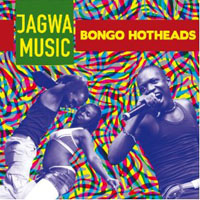
JAGWA MUSIC
BONGO HOTHEADS (Crammed Disc CRAW80)
Straight off the streets of Dar Es Salaam comes this fierce band of Bongo Hotheads. I haven't heard anything this intense and raw since Konono Numero Un. Jagwa Music is another fount of unstoppable energy. This ensemble have home-made drums and, as lead instruments, two old battered Casio keyboards wired to homemade amps. Singers and dancers complete the line-up. While the music is trancelike and repetitious, the fuzzy Casio lends grit and weirdness, and the pace suggests Afro-Punk. The mainstream media in Tanzania ignore this shanty-born music, deriding it as the music of thugs, but it has had a strong following for twenty years now as the band has continually renewed itself with young singers and performers. Vocally, the songs recall the old sound of Tanzania (Shikamoo and co), and are about lost love, voodoo and other popular topics. The producer of this hi-level insanity is Werner Graebner who has a distinguished career as one of the leading African musicologists today, author of Sokomoko. Popular culture in East Africa (Amsterdam, 1992). His record production credits include the Zanzibara series, Abana ba Nasery, Culture Music Club, as well as work on Mlimani Park Orchestra's Sungi and also Masimango, the great remastered reissue of Mbaraka Mwinshehe. While these wonderful albums are a treat to us in our small circle of cognoscenti, this Jagwa Music deserves to break out to worldwide acceptance and popularity.
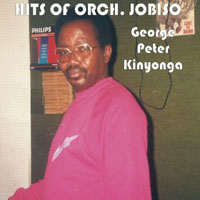
GEORGE PETER KINYONGA
HITS OF ORCH JOBISO (TCK Records)
I am really not happy about the direction the music industry is headed. Amazon and iTunes dominate the field of downloads and I have to ask, Is anyone listening? I mean really listening to music, either with good headphones or on a real sound system? Their bit-rate is miserable and when you reissue an album that was originally on cassette it is going to sound like you are hearing it in a tin can via a piece of string. (Unless you have Doug Paterson doing audio restoration!) Fortunately other sources are available for the Orchestre Jobiso reissue of pure "Muziki wa dansi" (which still has some warbly tape rumble moments in the bass). It's four of their hits (A side plus B side, with a gap in the middle, so if you are energetic you will have to edit the files to eliminate the silence in the middle) from the late 70s. There's a picture of George Peter Kinyonga about 100 pixels square and no other info, other than titles. George and his brother Wilson were the founders of the legendary Simba Wanyika in Tanzania, pioneers of Swahili rumba. They started out as Jamhuri Jazz in their hometown of Tanga, Tanzania, and then moved to Arusha where, inevitably, they evolved into Arusha Jazz. In 1970 they moved to Nairobi, Kenya, and became Simba Wanyika (Lions of the Desert). The Super Wanyika Stars story is relatively well known and Sterns has done a glorious job of reissuing the Issa Juma material recently. Orchestra Jobiso was George Peter's outfit after the fracture of the Wanyika band into several offshoots. The cassette, er download, collects four of his hits.
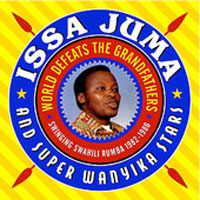
ISSA JUMA & SUPER WANYIKA STARS
WORLD DEFEATS THE GRANDFATHERS vol 2
MORE SWINGING SWAHILI RUMBA 1982-6 (Sterns download* in 320 bitrate from 7digital)
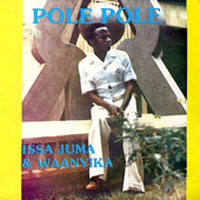
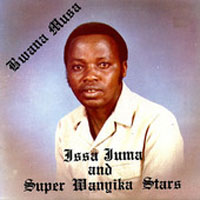
This is a download-only album you nevertheless have to own, and to satisfy your need to have something in your hands to look at while listening, you should pull out the booklet from Volume 1 and reflect that Sterns' East African series is now up to 5 discs and is catching up to the essential Guinea sets put out from 2007 onward (which is up to 5 double-disc sets). Don't worry there's plenty more great East African music & this disc is no less impressive than Volume 1. "Teresia," which was a smash hit single in the mid 1980s is included, as is "Sauda," a killer cut from the Mpita-Nija album (three of the four tracks from that album were on Volume 1, so completists will be thrilled!). The stellar "Sarah," another long-time favorite, which was included on Sigalame 2 is here, along with the title cut which may be the one Issa Juma track you know if you had that Discafrique album that came out in Europe in 1990. That was their breakthrough album to Western ears & I am glad it has been digitized because I played mine so much it skips now. It's a good thing Sterns decided to include it here because it is truly one of the great East African songs and, after 22 years, there may be some people who missed Les Wanyika Stars then. "Selemani" & "Pole Issa" are here with a few other tracks previously unknown, even to the congnoscenti! And if you recall the first volume ended with "Ma Eliza" in an unreleased version with a sax solo; this one ends with a different take of that same tune. In it you can hear Omar Shabani trying out some Franco-style staggered guitar licks. Interestingly Sterns still haven't got to their early work as Les Wanyika, songs like "Sina Makossa," "Pauline" and a few others from the late 70s that maybe will be on Volume 3. Doug Paterson writes: "It just speaks to the largely unrecognized talents of Issa Juma that practically everything he did for AIT still sounds great: great rumba with a Tanzanian sensibility with the benga pulse; and often, perhaps unintentionally, a raw / gritty sound that I find quite appealing." Though the good songs are all now collected on these two volumes, Stern's has also released two of the Wanyika LPs --Bwana Musa and Pole Pole -- with their original track lists, and you can download those Golden Oldies separately if you prefer. (*Ken A, who has more experience than I in these matters, reports that amazon and iTunes generally encode their files at 256 kbps; with emusic you never know what you're going to get -- sometimes half of that -- but other than 7digital, othermusic and dancetracksdigital sell music for the same price as amazon and iTunes.)
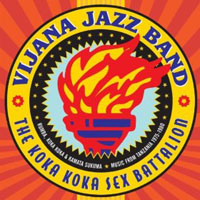
VIJANA JAZZ
THE KOKA KOKA SEX BATTALION (Stern's STCD3053)
From the time Stern's announced this release and started posting teasers on their website and Soundcloud, I have been as excited as a kid waiting for Santa. I have a lot of Vijana Jazz (11 cassettes and several tracks on comps), most of it slightly warbly sounding tapes, and a thrashed 45, as found on my Tanzanian discography page. Interestingly only one of those tracks I list, "Gubu la Mume," from Swahili Hits vol 4, is gathered here. The rest magically appeared from nowhere, or rather from the sleeve of Doug Paterson, compiler and annotator of this excellent series. Not only is this Tanzanian muziki wa dansi series going from strength to strength, it's impressive for two other reasons. First, the sound is restored to audio excellence. Yes, you can go off into the blogosphere or YouTube and find music sort of like this, but chances are if anyone has made an effort to clean it up they have just added a filter to make it more fuzzy sounding. If you don't have access to the source material you are starting at a disadvantage. Tapes may not have surface crackles like 45s, but are blighted by other problems. Secondly, not least among the attendant problems of this music "at a few removes" is the documentation. It's fine to have African music on your iTunes but if you don't know what the song is about, or who wrote it or why, it has less meaning.
Considerable sleuthing went into the discovery of these Vijana Jazz master tapes. First of all 6 of the tracks were released pseudonymously, under the imaginative title of The Koka Koka Sex Battalion. The reason was simple: the band's label in Tanzania thought they had enough material on the market, but the members were burning to record more recent stuff and knew if they drove to Nairobi, where there were good studios, they could cut some new songs and get paid for them, hence the surreptitious aspect of this venture. So after a New Year's Eve concert to bring in 1975, the hung-over members got into a truck with their guitars and amps and headed north to Kenya as Ali Mohamed, their driver, navigated the giant potholes and herds of goats along the red dirt highway. (That's conjecture on my part; maybe they stopped for a smoke or a leak and joked with Ali, calling him "the Greatest" after his namesake, Mohammed Ali who had electrified the world by beating George Foreman for the World Heavyweight boxing title two months earlier in Kinshasa.) What we learn from Paterson is that the studio they chose was famous as the home of Benga music, and the band adapted Kenyan musical ideas into their style, as well as the pervasive sound of Congo, noticeable when they shout out "Sukisa!" at the start of a wonderful jam, "Ujirani mwema (good neighbours)," a praise song for Zaireans, Kenyans, Kenyatta, Harambee (the "Work together" concept drilled into the wananchi), Zambians, and so on. But the flailing drums and congas, blaring horns and choppy guitars are 100% Tanzanian, as heard on "Gwe Manetu Fii," by lead singer Hemedi Maneti and second vocalist Issa Chikupele. Maneti has a wonderful raspy voice and clearly their fans would have known who the Sex Battalion really were from the catch-phrases they shout out. Once again one of my albums of the year is a reissue from long ago, but that's part of aging and realizing the old guys had it right the first time.
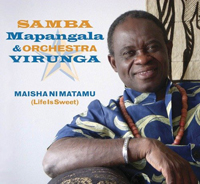
SAMBA MAPANGALA & ORCH VIRUNGA
MAISHA NI MATAMU (Virguna VR003)
Samba is back with the message "Maisha ni matamu (Life is sweet)" & he brings some bright danceable rhythms reminiscent of the golden age of Virunga in Nairobi in the early 80s. His new 38-minute long album features a load of guest talent crammed into 7 cuts, some of them actually recorded in Nairobi. On guitar he welcomes Syran Mbenza of Quatre Etoiles, Nseka Huit Kilos formerly with Rochereau's band, and Popolipo from Zaiko Langa Langa: three of the greats. Ballou Canta pops up on vocals and Jimmy Mvondo also brings his sax, along with drummer Komba Bellow, who has appeared on the last few Virunga albums as well as being a mainstay of Quatre Etoiles. Samba sings about the Sauti za Busara festival in "Zanzibar": his appearances there to great acclaim have done a lot to bring him back to the consciousness of the wananchi of East Africa. The album also includes "Les Gorilles des Montagnes" (which came out as a single last year) a song about the endangered gorillas of Mount Virunga in Northeastern Congo. I can attest to how endangered they are because I spent a week in July 1983 trying to catch a glimpse of them, to no avail. However, I did climb the mountain, a dormant volcano, and gained a closer affinity with the band and, after all, what do you do when you meet a gorilla? Avoid eye contact and turn your back to them, bend over and pretend to graze the grass! And despite their sad circumstances it was far more exciting running into the Mbuti pygmies. Samba's new CD, like life itself, is short. It ends with a pleasant coasting instrumental take of "Jarani," a reggae-like number in which Huit Kilos revisits some of his riffs from the days of Afrisa.
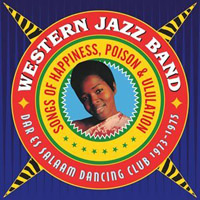
WESTERN JAZZ BAND
SONGS OF HAPPINESS, POISON & ULULATION (Stern's STCD3052)
Doug Paterson strikes again! I have corresponded with this expert in the music of East Africa but somehow Western Jazz Band never breached my consciousness 'til now. Based in the Dar Es Salaam Dancing Club, the band had a career that spanned two decades, but for this reissue, Paterson has picked choice tunes from the brief period 1973-5 that showcase this guitar-heavy band from Western Tanzania and their style of music, called Saboso. The lyrics are all transcribed and translated so we can check out the songs about poisoning a lover or less problematic domestic issues from hardship to greed, trust, bad friends and/or calamity. "Amina" is familiar to me because of the harmony horn chorus and the ringing lead guitar played with lots of echo. The singer urges Amina to finish her studies before they get married. Instead of the pulsing hi-hat or bomping kick drum found in a lot of East African music from the period, the percussion is on congas and the saxophonist is more prominent. However, there are the trademark dueling lead guitars and one of them occasionally starts strumming behind the bridge of his electric guitar to create that chunking percussive beat. Unlike music from the rest of Africa there are no external influences: no Latin quotes, no funk or Britpop, no soul or R&B, just pure inventive harmonies and catchy melodies.
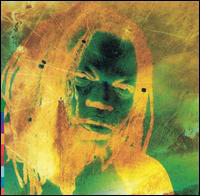
cover for Songs for the Poor Man
REMMY ONGALA IN MEMORIAM
Born in Congo, REMMY ONGALA moved to Tanzania and performed with Super Makassy of his uncle Mzee Makassy. Ongala rapidly became the frontman resulting in a fracture of the band (when Makassy decided to move to Kenya), after which Ongala became involved with Orchestre Matimila, renamed Super Matimila. Ongala also performed with Super Talakaka and their album Penzi ni jahazi (Polydor POLP 538) was a smash hit, though Ongala later said he had no idea how the album came out or who got the money. But this brought his music to Western attention and he hit UK with the stunning album Nalilia Mwana (his first of four albums produced by Peter Gabriel). Thereafter he performed regularly at WOMAD. In fact the only time I saw him perform was at the one-off WOMAD/San Francisco in Golden Gate Park. Fortunately he was up against Ziggy Marley so when Ziggy took the main stage everyone flocked there except those 100 or so of us who knew the real event was going to be on the minor stage. We had the "dance floor" to ourselves. He had a distinctive sound, influenced structurally by Franco's OK Jazz, with Boss Flangers on the guitars and a lyric delivery that is instantly recognizable. If you don't understand the lyrics his songs tend to sound similar but he had potent messages in his words. He was a deeply concerned songwriter who wrote about social injustice, death, AIDS, and other pressing matters. I heard from a musician that Ongala was a terrible boss, a real martinet who would fire anyone who played a lick out of turn. But that's not so unusual among singer-songwriters who know what they want. His Songs for the Poor man came out on the RealWorld label, as did Mambo, while Sema came out on WOMAD in 1995 and reincorporated some of his hits, such as "Kilio (the fish song)," "Fadhili ni utumwa," and "Nalilia Mwana." We were even treated to a Kershaw Sessions disc of 12 songs done live to supplement the early On Stage album which had come out in Tanzania (on cassette; later issued in Kenya as Ahadi LP6007, 1988). His later UK albums tended to recycle his old songs, which is fine as they were better recorded. In 1996, when he returned from a world tour, his passport was revoked and he couldn't leave Tanzania, though he did not have citizenship there. Around 2001 he was paralyzed by illness. He had a second stroke in 2003 at which point the government agreed to naturalize him (but not his wife and children). Mzee Makassy came to his aid and also to covert him to his fundamentalist church. He recorded some religious cassettes which sold well among the poor and downtrodden of Tanzania. He died at home, December 2010, in Tanzania where he was a national hero and given a funeral as big as Nyerere's. [Thanks to Pauly Becquart for correcting facts]
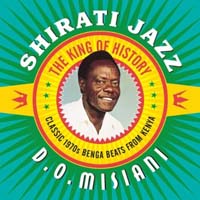
D. O. MISIANI & SHIRATI JAZZ
THE KING OF HISTORY (Sterns STCD3051)
The first thing you have to be ready for with Benga music is the shrill voices. They are not unnaturally high like Bollywood playback singers, but still they strain up an octave. Then you can get into the sheer propulsive energy of it. It is perhaps the speediest music from Africa, and it is stripped for action: two guitars, bass and drums with only occasional sax, or even bottle percussion. Misiani is (or was) the master: this collection comes from the 1970s, which was his greatest era. Misiani, a talented guitarist himself, brought up on Losta Abele, Bosco, et al, assembled the best possible band -- so you don't have a rhythm guitarist strumming on an open chord, a bass playing the one and a drummer keeping a four-square beat: you have four individuals playing their hearts out from the word go. The bass is the most unusual: he is soloing throughout, paying very little attention to the tune or the other musicians. The two guitarists also don't really play together, they make little musical sorties, only occasionally at the same time. The drums are quite bizarre actually. In his classic novel, The Music in my Head, Mark Hudson has a very funny passage about the greatest air guitar song of all time: He goes on about this gem of rock & roll, and then says that when the drums come in they are so badly recorded it ruins everything. The Kenyan drums are not badly recorded, just badly made, I think. They sound like plastic buckets, very different from other trap drums on record. But the high energy guitars and insane bass soloing completely overwhelm any need for sonic fidelity on the tubs. Amazingly, the two albums released in the UK in the late 80s presented a strong showing of Misiani's music, and hooked a lot of us on Benga, but this earlier material is even better!
The CD notes don't say who is on here. However the 1989 album PINY OSE MER, which has liner notes by Werner Graebner, lists D.O. as bandleader, solo guitar and voice, Ochieng Oninga as first rhythm guitar, Juma Obai as 2nd rhythm guitar, and Nyabuon Nyang as merely the rhythm guitar. Two bassists are identified: Okech Oro and Pasy Aloo, with Caleb Odemba on drums. I don't know how many of them were in the band two decades earlier. Trying to explain the name, a fan said "Benga is the feeling you get when dancing." The music was influential in neighbouring Zambia and Zimbabwe, but also as far away as Nigeria where it was popular among fans of Ibo highlife. The direct influences on the sound might be traced to the orutu, a traditional one-stringed violin, or the nyatiti, the 8-stringed lyre. These can be heard on the Hugh Tracey recordings of the 50s, if you want to look for parallels in the rhythm and lead guitar. Although the Luo are only the third-largest ethnic group in Kenya their music became hugely popular in the 70s and eclipsed the other forms of Swahili- and Congolese-language dance music in East Africa. Misiani's pointed lyrics (couched in fables and folk tales) often got him in trouble with the authorities, and he was once arrested as an illegal immigrant (being from Tanzania) but not deported. At their peak Shirati Jazz sold 20,000 singles a month in the 70s, but in the 80s piracy and cassettes severely dented the African music industry. Misiani, who died in 2006, would have been amused that Barack Obama, son of a Luo man, became president of the United States while Kenya has never had a Luo president, Doug Paterson tells us in his liner notes. The booklet includes photos and translations of all the songs.
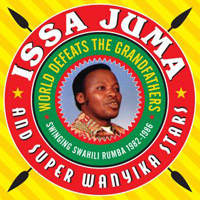
ISSA JUMA & SUPER WANYIKA STARS
WORLD DEFEATS THE GRANDFATHERS (Sterns STCD3050)
While the music industry is going through great upheavals as modes of distribution are changing overnight, it's reassuring to know there are still labels with confidence to put out classic music that will have a limited appeal, in the hopes that a broader audience will develop for it. Maybe folks will appreciate it enough to support such ventures and not screw them into oblivion by stealing it. Stern's have apparently closed their flagship London store but the label is going strong & this release signals, hopefully, a move to East Africa after their triumphant series of Guinean danceband classics compiled by Graeme Counsel. Most of us in the West first heard Issa Juma on Sigalame 2, the phenomenally great 1990 compilation from Discafrique. Issa's throaty baritone was irresistible. I played "Pole pole" so many times my LP has skips in it. The story of his band, Les Wanyika, has been told before: suffice it to say they were the top Kenyan band in the 80s, resisting the onslaught of talent from the Congo that included Samba Mapangala, Moreno Batamba, Lovy Longomba and many others. The founders of Simba Wanyika (Lions of the Wild), Wilson and George Peter, played dueling lead guitars and Professor Omar backed them on rhythm, but their singer, Tanzanian-born Issa Juma wanted more control and so, inevitably, the group split and many other factions with many other names (Super Wanyika, Super Les Les, Wanyika Stars, etc) appeared. However this compilation has the constancy of Juma's fabulous vocals atop all of it and documents only the latter part of his meteoric career with Super Wanyika Stars. So, although the album is drawn from five different sessions, it's all unmistakably Issa's music. The compilation is by Douglas Paterson, leading musicologist of the East African field, and broadcaster on KBCS radio, who has previously given us such gems as The Nairobi Beat (Rounder) and one of my all-time favourite LPs Karubandika by Orchestra Maquis Original from Tanzania. The album kicks off with "Barua (The Letter)", a minor gem that was on the LP Mpita-Njia. Two more cuts from that 4-track disc appear here in all their restored glory. Then we hear a previously unreleased "sax" version of "Ma Eliza" which is consequently new to everyone. "Mwanaida" was on the B side of the Bwana Musa LP, while "Utalia na nani" is culled from the B side of the great Pole pole (slowly slowly) disc that was the basis of the Discafrique release. Chances are, you don't have most of these, unless, like me, you have been trying to track them down for the last 30 years (since they came out). There's a great spareness to the sound. You can hear the ticking high-hat, bustling bass and the interplay of the busy fingerpicked guitars, but it's mostly about the vocals. For a comparison I played "Si mimi," the opening track on Mpita-njia and then the restored version. I couldn't believe it: the new version has much more defined stereo separation and is crisper. Not only are all the pops & ticks from the vinyl gone, there is a vast dynamic range as big as the Rockies wherein you can hear both guitars, bass and drums as clear as ether. The sax solos also nicely complement Issa's voice. This is the way it was meant to be heard and lifting the veil of muteness (that comes from cassettes and badly dubbed LPs) enhances your pleasure in hearing this fantastic singer, his chorus and musicians as he sounded in the A.I.T. studio. There is a crying baby on the song "Utalia na nani?" which I find annoying, but I suppose it was a novelty at the time. The disc ends with another gem: the original Kenyan mix of "Mony," a lovelorn ballad. It differs from the version on Sigalame 2. There is a "download-only" track, "Ateka," for those buying the album on MP3 from iTunes or Amazon, that was also included on Sigalame 2, and is well-worth having.